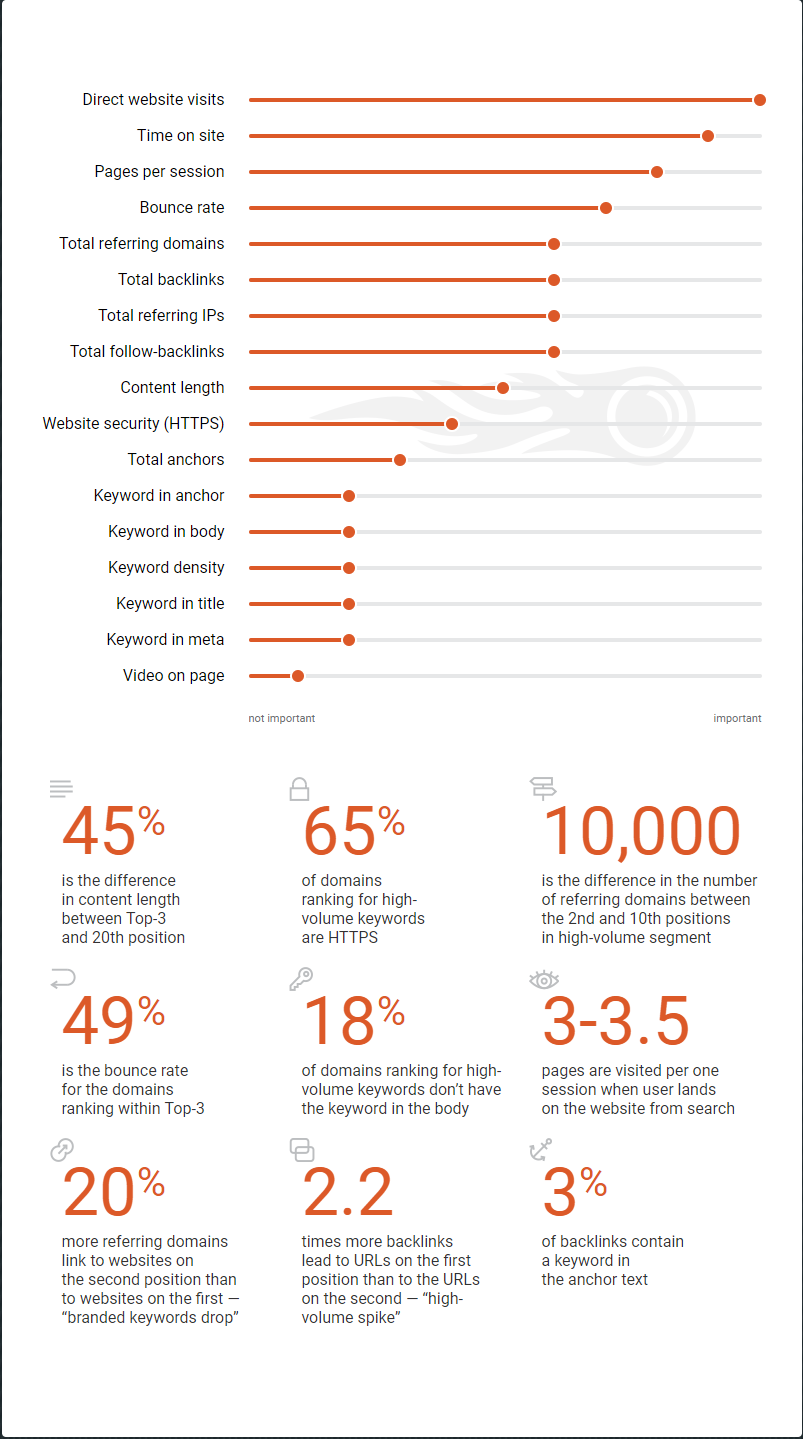The most important goal of search engine optimization (SEO) is obviously, rankings. Of late, digital marketers have been trying to downplay the importance of rankings in favor of more branded signals to Google’s search algorithms, in an attempt to conform to the search behemoth’s quality guidelines.
However, your site’s rankings for your chosen keywords will always be important until search results are displayed in order of 1, 2, 3… No surprise then, that in-house SEO experts and agency marketers alike are always on the lookout for every little technical tweak that can take them one step closer to the elusive No. 1 position on Google.
SEO and digital marketing tool suite SEMrush (the de-facto industry leader) has conducted one of the most in-depth studies ever into the ranking factors that take a website to the top of Google.
Their machine learning based analysis of 6 lakh search results from 10 crore real internet users searching across Google’s Indian, US, UK and other versions throws up some interesting facts on how they rank websites!
If you can’t wait to dig into the full technical study yourself, download it here: SEMrush: Ranking Factors 2.0.
For a high-level analysis, read on.
Here’s a graphic that shows the 17 most crucial signals for ranking on Google:
Image Credits: https://www.semrush.com/ranking-factors/
There are some clear takeaways that emerge from the study…
Direct website traffic tops all other factors.
This is the single most significant finding of this study. Direct traffic is when the user comes to your website straight from the browser (by entering your URL in the address bar or clicking a bookmark) or a saved document (such as PDF), instead of clicking through from the search results or social media shares.
Numerous other studies on ranking factors have neglected to consider this critical factor, because of the possibility of correlation – i.e. Google ranks the best sites, but naturally, the best sites have more traffic.
However, the SEMrush study highlights Google’s increasing focus on the “brand authority” of a website. When direct traffic to a site increases, it is a strong indication that the brand is growing stronger. This means businesses need to redouble their PR efforts to build brand awareness and brand affinity for their products, inducing customers to proactively search for their brand terms
You may also like:
- SEO PowerSuite Review & Tutorial: The Best SEO Tool
- SEO Checklist : 75+ Killer Steps To Make Your Site SEO Friendly
- The Pros and Cons of DIY SEO – Infographic
Eventually, Google will pick up on these “entity searches” and pass on the credit to your website.
User experience is paramount to success.
Google has repeatedly advised digital marketers to chase users instead of the algorithm. And they plainly mean it. Direct traffic is followed by three metrics closely related to user behavior on the ranking factors chart:
- Time on site: The amount of time the average user spends on the site per visit
- Pages per session: The number of pages viewed by a user per visit
- Bounce rate: The ratio of visitors who leave your site after viewing a single page to those who stick around for more
Taken together, these three metrics tell Google whether or not users really find what they’re looking for on your website, and how engaging it is to your audience. In marketing parlance, they reveal the “relevance” of your content to the searcher’s “intent.”
These user-specific ranking factors underscore the value of your content. Google has time and again emphasized the importance of creating quality content through their webmaster guidelines and hangouts. If your site delivers what users are looking for, Google is sure to reward you for it.
Links do matter.
Backlinks are at the building blocks of Google’s original PageRank algorithm, which still forms the core of its ranking system. This is reflected in the fact that elements number 5 to 8 on the chart are link-specific metrics. The quantity and quality of backlinks, the variety of domains they come from as well as the spread of their IP addresses, all play a role in pushing up your rankings.
While Google discourages link building solely for SEO purposes, the fact remains that great content garners the maximum amount of links, along with closely relevant anchor text. This, in turn, plays a big role in enhancing brand authority, eventually bringing more referral as well as direct traffic (the biggie, remember?) to the website.
Ultimately, it’s important not to focus narrowly on any single aspect of link building, such as IPs or “followed” links. Marketers should focus on developing a diverse backlink profile, built on the back of multi-channel PR and content marketing.
You can start small with low-volume keywords, and eventually move on to targeting the more competitive ones, as your content base increases and your existing links start to bring in traffic.
Google is on a mission to make the web safer with HTTPS.
Google is going all out to persuade webmasters across the world to move to HTTPS in their quest to make the web a secure place. HTTPS maintains the integrity of your website data, prevents intruders from tapping into your communication with users, and protects their privacy.
Google is doing everything it can to coax website owners into adopting HTTPS – and they’ve found a simple, but effective way: ranking HTTPS sites above their HTTP counterparts, all else being equal.
If you’re still biding your time, the time to make the switch has come. The higher the volume of keywords you’re targeting and the bigger your website, the more important HTTPS adoption becomes. Without a secure site, you’ll soon be relegated to the sidelines and watch your rivals pass you by.
Keywords are losing their shine.
SEO practitioners have been terribly obsessed with keywords for a long, long time. This has frequently led them to cross the line into spamming, by stuffing HTML tags and content with keywords, giving the SEO industry a bad name and lessening its importance.
Also, read:
- How to Re-optimize Old Blog Post in 10 Minutes: Improve Ranking & Traffic
- Semrush vs Serpstat : Which is the Best Keyword Research Tool?
- Does Web Hosting Affect SEO Rankings ? Yes! Check How
- How Google RankBrain Algorithm Changed the Course of SEO
With updates like Hummingbird and RankBrain, Google has got its act together when it comes to semantics and understanding content. Peppering your headlines, copy and meta tags with keywords will no longer give you even a slight advantage.
SEMrush found that more than 35% of sites that ranked for high-volume keywords didn’t even have the keyword in the title. Talk about meeting users’ intent by speaking their language!
Over to You
SEO forms the core of your digital marketing efforts. When it comes to building an effective SEO strategy that works for your business, every little bit helps. Engaging content, brand authority, links from the right places and a secure website, all play their part. Analyzing Google’s algorithm is a complex and demanding process, and it pays to stay updated on the factors that influence rankings. Good luck!
Quick Links:









Hi,
It’s really helpful .Thanks for sharing
Good information thanks for sharing
Very useful information. Guys keep us the good work.